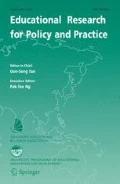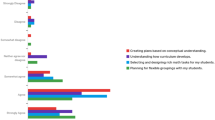Abstract
Mathematics teachers, mathematics department heads, curriculum leaders, and administrators from 11 schools in four school boards from Toronto, Ontario, Canada, participated in a project to improve the teaching and learning in grade 9 mathematics classrooms. In each of these schools, an implementation team was created, so that at least three teachers from every school could collaborate, in order to improve learning outcomes of their students. This article reports on the challenges identified by teachers when they taught grade 9 applied mathematics. Teachers’ views of challenges fell into five main layers: (a) teacher professional development and pedagogical skills, (b) student learning needs, (c) settlement issues and families’ social and economic background, (d) administrative difficulties and resources, and (e) curricular issues. These challenges were complex and interconnected, demanding special remedial efforts by the administration and teachers. By reflecting on the challenges and practices, these teachers made a long-term strategy to engage in professional development activities to better understand their students’ learning needs and to improve their achievement in provincial tests.
Similar content being viewed by others
References
Anyon, J. (1997). Ghetto schooling: A political economy of urban educational reform. New York: Teachers College Press.
Bol, L., & Berry, R. Q. (2005). Secondary mathematics teachers’ perceptions of the achievement gap. High School Journal, 88(4), 32–45.
Burkhardt, H. (2006). Modelling in mathematics classrooms: Reflections on past developments and the future. The International Journal of Mathematics Education, 38(2), 178–195.
Cavanaugh, M. (2006). Mathematics teachers and working mathematically: Responses to curriculum change. In P. Grootenboer, R. Zevenbergen, & M. Chinnapan (Eds.) Identities, cultures and learning spaces. Proceedings of the 29th annual conference of the Mathematics Education Research Group of Australasia, Canberra (pp. 115–122). Sydney: MERGA.
Christie, C. E., & Fleisher, D. (2009). Social inquiry paradigms as a frame for debate on credible evidence. In S. I. Donaldson, C. E. Christie, & M. Mark (Eds.), What counts as credible evidence in applied research and evaluation practice (pp. 19–30). London: Sage.
Cummins, J. (2001). Empowering minority students: A framework for intervention. Harvard Educational Review, 71(4), 649–676.
Dewey, J. (2008). Democracy and education: An introduction to the philosophy of education. New York: Macmillan Company.
Egodawatte, G., McDougall, D, Stoilescu, D. (2011). The effects of teacher collaboration in Grade 9 Applied Mathematics. Educational Research for Policy and Practice, 10(3). Retrieved online from http://www.springerlink.com/content/j6hq56751315r417/.
Galton, M. (2009). Moving to secondary school: Initial encounters and their effects. Perspectives on Education, 2, 5–21.
Giddings, L. S. (2006). Mixed-methods research positivism dressed in drag? Journal of Research in Nursing, 11(3), 195–203.
Gilbert, S. L. (1997). The “four commonplaces of teaching”: Prospective teachers’ beliefs about teaching in urban schools. The Urban Review, 29(2), 81–96.
Griner, A. C., & Stewart, M. L. (2013). Addressing the achievement gap and disproportionality through the use of culturally responsive teaching practices. Urban Education, 48(4), 585–621.
Groulx, J. G. (2001). Changing preservice teacher perceptions of minority schools. Urban Education, 36(1), 60–92.
Hennings, J. (2010). Public stories of mathematics educators: New curriculum: Frustration or realization? Journal of Urban Mathematics Education, 3(1), 19–26.
Herbst, S. (2009). Teacher perceptions of poverty and elementary school student achievement. Unpublished dissertation from the University of Missouri-Columbia.
Jacob, B. A. (2007). The challenges of staffing urban schools with effective teachers. The Future of Children, 17(1), 129–153.
Jarvis, D. H. (2006). Tracking the T.I.P.S. mathematics document: Curriculum negotiation and professional development models. Unpublished doctoral thesis, University of Western Ontario, London, Ontario, Canada.
Kajander, A., & Zuke, C. (2007). Factors contributing to success for intermediate students of mathematics: The needs of the teacher and the characteristics and needs of students at- risk. Northern Ontario Education Leadership (NOEL) Learning to 18 Report of the Faculty of Education, Lakehead University. Retrieved May 15, 2013 from http://noelonline.ca/depo/fdfiles/KajanderNOEL%20FINAL%20report%20APRIL%2030%202007.pdf.
Kajander, A., Zuke, C., & Walton, G. (2008). Teaching unheard voices: Students at-risk in mathematics. Canadian Journal of Education, 31(4), 1039–1064.
King, G. A., Baldwin, P. J., Currie, M., & Evans, J. (2005). Planning successful transitions from school to adult roles for youth with disabilities. Children’s Health Care, 34(3), 193–216.
Lincoln, Y., & Guba, E. (1985). Naturalistic inquiry. Beverly Hills, CA: Sage.
Lippman, L., Burns, S., & McArthur, E. (1996). Urban schools, the challenge of location and poverty. NCES 96–184. U.S. Department of Education, Office of Educational Research and Improvement.
Loucks-Horsley, S., & Matsumoto, C. (1999). Research on professional development for teachers of mathematics and science: The state of the scene. School Science and Mathematics, 99(5), 258–271.
McDougall, D. E., Jao, L., Maguire, K., Stoilescu, D., & Egodawatte, G. (2010). Collaborative Teacher Inquiry project for Grade 9 Applied Mathematics. Toronto, Canada: Ontario Institute for Studies in Education.
Migration Policy Institute. (2014). Global remittance guide. Retrieved July 22, 2014 from http://www.migrationpolicy.org/programs/data-hub#map1list.
Morgan, D. L. (2014). Pragmatism as a paradigm for Social Research. Qualitative Inquiry, 20(8), 1045–1053.
Mosqueda, E. (2010). Compounding inequalities: English proficiency and tracking their relation to mathematics performance among Latina/o Secondary school youth. Journal of Urban Mathematics Education, 3(1), 57–81.
Nelson, R. S. (1997). Developing mathematical knowledge through class discussion: One teacher’s struggles in implementing reform. Unpublished doctoral dissertation from Virginia Polytechnic Institute and State University.
Ontario Ministry of Education. (2001). Special education: A guide for educators. Toronto: ON, Government of Ontario Press.
Ontario Ministry of Education. (2005). The Ontario curriculum, grades 9–10: Mathematics (revised). Toronto ON: Government of Ontario Press.
Ontario Ministry of Education. (2006). Mathematics Transfer Course, grade 9, Applied to Academic, 2006, Toronto: ON, Government of Ontario Press.
Ogbu, J. U. (1992). Understanding cultural diversity and learning. Educational Researcher, 21(8), 5–14.
Rorty, R. (1979). Philosophy and the mirror of nature. Princeton: Princeton University Press.
Ross, K. E. (2014). Professional development for practicing mathematics teachers: A critical connection to English language learner students in mainstream USA classrooms. Journal of Mathematics Teacher Education, 17(1), 85–100.
Statistics Canada. (2005). Proportion of foreign-born population, by census metropolitan area (1991 to 2001 Censuses). Retrieved November 20, 2010 from http://www40.statcan.gc.ca/l01/cst01/demo47a-eng.htm.
Statistics Canada. (2006). The 2006 census. Retrieved December 2, 2010 from http://www12.statcan.ca/english/census06/.
Stoddart, T. (1993). Who is prepared to teach in urban schools? Education and Urban Society, 26(1), 29–48.
The Education Quality and Accountability Office (EQAO). (2012). Highlights of provincial results.
Thomas, D. R. (2006). A general inductive approach for analyzing qualitative evaluation data. American Journal of Evaluation, 27(2), 237–246.
Tilleczek, K. (2008). Building bridges: Transitions from elementary to secondary school. Education Canada, 48(1), 68–71.
Walker, E. N. (2007). Preservice teachers’ perceptions of mathematics education in urban schools. The Urban Review, 39(5), 519–540.
Whitley, J., Lupart, J. L., & Beran, T. (2007). Differences in achievement between adolescents who remain in a K-8 School and those who transition to a junior high school. Canadian Journal of Education, 30(3), 649–669.
Author information
Authors and Affiliations
Corresponding author
Rights and permissions
About this article
Cite this article
Stoilescu, D., McDougall, D. & Egodawatte, G. Teachers’ views of the challenges of teaching grade 9 applied mathematics in Toronto schools. Educ Res Policy Prac 15, 83–97 (2016). https://doi.org/10.1007/s10671-015-9178-z
Received:
Accepted:
Published:
Issue Date:
DOI: https://doi.org/10.1007/s10671-015-9178-z



